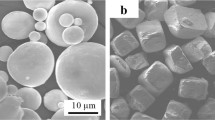Abstract
It is well known that interstitials affect the mechanical properties of titanium and titanium alloys. Their effects on the fatigue properties of titanium foams have not, however, been documented in the literature. This paper presents the effect of the oxygen content on the static and dynamic compression properties of titanium foams. Increasing the oxygen content from 0.24 to 0.51 wt% O in solution significantly increases the yield strength and reduces the ductility of the foams. However, the fatigue limit is not significantly affected by the oxygen content and falls within the 92 MPa ± 12 MPa range for all specimens investigated in this study. During cyclic loading, deformation is initially coming from cumulative creep followed by the formation of microcracks. The coalescence of these microcracks is responsible for the rupture of the specimens. Fracture surfaces of the specimens having lower oxygen content show a more ductile aspect than the specimens having higher oxygen content.














Similar content being viewed by others
References
Cameron HU, Pilliar RM, McNab I. The effect of movement on the bonding of porous metal to bone. J Biomed Mater Res. 1973;7(4):301–11.
Bobyn JD, Pilliar RM, Cameron HU. The optimum pore size for the fixation of porous surfaced metal implants by the ingrowth of bone. Clin Orthop Relat Res. 1980;150:263–70.
Conrad H. Effect of interstitial solutes on the strength and ductility of titanium. Prog Mater Sci. 1981;26:123–403.
Murray JL, Wriedt HA. The O–Ti (oxygen–titanium) system. Bull Alloy Phase Diagrams. 1987;8:148–65.
Ottaviani G, Nava F, Quierolo G, Iannuzzi G, De Santi G, Tu KN. Low temperature oxygen dissolution in titanium. Thin Solid Films. 1987;146:201–7.
Wasz ML, Brotzen FR, McLellan RB, Griffin AJ Jr. Effect of oxygen and hydrogen on mechanical properties of commercially purity titanium. Int Mater Rev. 1996;41(1):1–12.
ASTM standard F 67-00, Standard Specification for Unalloyed Titanium, for Surgical Implant Applications (UNS R50250, UNS R50400, UNS R50550, UNS R50700).
ASTM standard F 1341-99, Standard Specification for Unalloyed Titanium Wire UNS R50250, UNS R50400, UNS R50550, UNS R50700).
ASTM standard F 1108-97a, Standard Specification for Titanium and Titanium-6 Aluminum-4 Vanadium Alloy Casting for Surgical Implants (UNS R56406).
ASTM standard F 136-98, Standard Specification for Wrought Titanium-6 Aluminum-4 Vanadium ELI (Extra Low Interstitial) Alloy (UNS R56401) for Surgical Implant Applications.
ASTM standard F 1472-02a, Standard Specification for Wrought Titanium-6 Aluminum-4 Vanadium Alloy for Surgical Implant Applications (UNS R56400).
ASTM standard F 1580-01, Standard Specification for Titanium and Titanium-6 Aluminum-4 Vanadium Alloy Powders for Coatings of Surgical Implants.
Yue S, Pilliar RM, Weatherly GC. The fatigue strength of porous-coated Ti-6Al-4V implant alloy. J Biomed Mater Res. 1984;18:1043–58.
Cook SD, Georgette FS, Skinner HB, Haddad RJ Jr. Fatigue properties of carbon- and porous-coated Ti–6Al–4V alloy. J Biomed Mater Res. 1984;18(5):497–512.
Fragomeni JM. Effect of heat treating on the microstructure and fatigue behavior of a Ti-6wt.%Al-4wt.%V ELI alloy. J Adv Mater. 2001;33(3):18–25.
Arciniegas M, Aparicio C, Manero JM, Gil FJ. Low elastic modulus metals for joint prosthesis: tantalum and nickel-titanium foams. J Eur Ceram Soc. 2007;27(11):3391–8.
Sevilla P, Aparicio C, Planell JA, Gil FJ. Comparison of the mechanical properties between tantalum and nickel-titanium foams implant materials for bone ingrowth applications. J Alloy Comp. 2007;439(1–2):67–73.
Barrabés M, Sevilla P, Planell JA, Gil FJ. Mechanical properties of nickel-titanium foams for reconstructive orthopaedics. Mater Sci Eng C. 2008;28(1):23–7.
Zardiackas LD, Parsell DE, Dillon LD, Mitchell DW, Nunnery LA. Structure, metallurgy, and mechanical properties of a porous tantalum foam. J Biomed Mater Res. 2001; 58(2):180–7.
Lefebvre LP, Thomas Y. Method of Making Open Cell Material, US patent 6,660,224 B2, Dec. 9, 2003.
Lefebvre LP, Baril E. Effect of oxygen concentration and distribution of the compression properties of titanium foams. Adv Eng Mat. 2008;10(9):868–76.
Ashby MF, Evans A, Fleck NA, Gibson LJ, Hutchinson JW, Wadley HNG. Metal Foams. A design Guide. Cambridge: Butterworth Heinemann; 2000.
Lütjering G, Williams JC. Titanium. 2nd ed. Springer: Pirna; 2007. p. 188.
Zioupos P, Gresle M, Winwood K. Fatigue strength of human cortical bone: age, physical, and material heterogeneity effects. J Biomed Mat Res A. 2008;86A(3):627–36.
Choi K, Goldstein SA. A comparison of the fatigue behaviour of human trabecular and cortical bone tissue. J Biomech. 1992;25:1371–81.
Carter DR, Hayes WC. Compact bone fatigue damage. I. Residual strength and stiffness. J Biomech. 1977;10:325–37.
Acknowledgments
The authors would like to acknowledge J.-P. Nadeau, S. Mercier, M. Plourde, D. Simard, F. Borgis and Dr. S. Lang for their contributions in the experimental work.
Author information
Authors and Affiliations
Corresponding author
Rights and permissions
About this article
Cite this article
Lefebvre, L.P., Baril, E. & Bureau, M.N. Effect of the oxygen content in solution on the static and cyclic deformation of titanium foams. J Mater Sci: Mater Med 20, 2223–2233 (2009). https://doi.org/10.1007/s10856-009-3798-x
Received:
Accepted:
Published:
Issue Date:
DOI: https://doi.org/10.1007/s10856-009-3798-x




